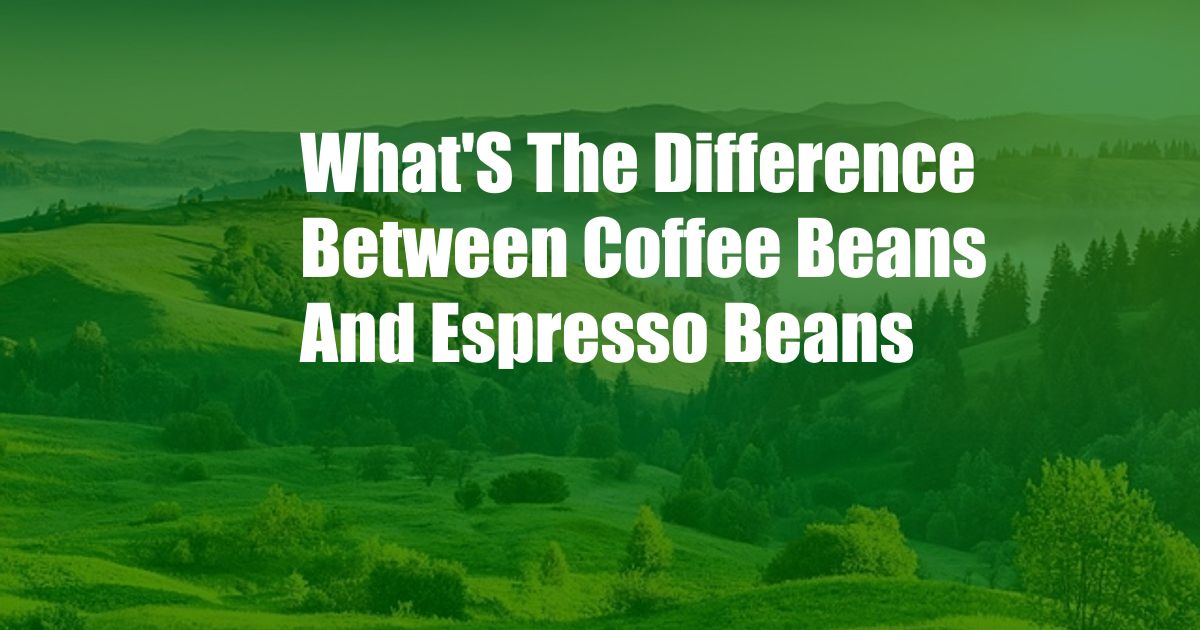
What’s the Difference Between Coffee Beans and Espresso Beans?
As a coffee enthusiast, I’ve always been fascinated by the distinction between coffee beans and espresso beans. They may seem like two different sides of the same coin, but delve deeper, and you’ll discover a rich and complex world of differences that coffee lovers should understand.
Before we dive into it, let’s establish the basics: Coffee and espresso beans are both derived from the same plant, Coffea Arabica or Coffea Robusta. However, the processing, roasting, and brewing methods are where the divergence occurs, creating two distinct coffee experiences.
Coffee Beans vs. Espresso Beans: The Grind Matters
Coffee Beans: Ground for a Balanced Brew
Coffee beans can be ground to suit various brewing methods, from French press to pour-over. The grind size determines the extraction rate, water flow, and ultimately the flavor profile of the coffee. Coarser grinds extract fewer compounds, resulting in lighter-bodied and less intense coffee. Conversely, finer grinds maximize extraction, producing more robust and flavorful brews.
Espresso Beans: Finely Ground for Pressure Extraction
Espresso beans, on the other hand, are specifically ground to a very fine consistency. This is essential for the unique extraction process employed in espresso machines. The finely ground coffee provides more surface area for water to interact with, resulting in a concentrated, thick, and flavorful brew in under a minute.
Roasting Characteristics: Darker for Espresso
The roasting process significantly changes the characteristics of coffee beans. Coffee beans are classified into three main roast levels: light, medium, and dark. Each level imparts different flavors, aromas, and caffeine content to the roasted coffee.
Espresso beans are typically roasted darker than coffee beans for regular brewing. The darker roast time brings out bold, intense flavors and produces a fuller body. It also reduces acidity and bitterness, allowing the espresso’s signature richness to shine through.
Brewing Methods: Pressure vs. Pouring
The brewing method is another key differentiator between coffee beans and espresso beans. Coffee beans are widely used in various brewing techniques such as drip, French press, and pour-over. These methods use gravity or a slow passage of water to extract the coffee’s flavor and aroma.
Espresso, on the other hand, is brewed using a specialized espresso machine. Hot water is forced through finely ground espresso beans under high pressure, extracting concentrated coffee in a matter of seconds. This pressurized brewing technique creates a unique combination of flavors, a thick crema, and a distinct caramelized aftertaste.
Latest Trends and Developments
The coffee industry is constantly evolving, with new trends and developments emerging regularly. In the realm of coffee beans and espresso, there are several noteworthy updates and innovations.
One notable trend is the growing popularity of specialty coffee. Coffee enthusiasts are seeking out single-origin beans, highlighting the unique flavors and characteristics of specific growing regions. This shift towards quality has driven innovation in sustainable farming practices and bean sourcing.
Tips and Expert Advice for Coffee Aficionados
As you explore the world of coffee, there are a few tips and expert advice that can enhance your coffee experience.
To fully appreciate the nuances of coffee and espresso, consider visiting local coffee shops that roast and prepare their own beans. Interacting with knowledgeable baristas will broaden your understanding and introduce you to a variety of roasts and brewing methods.
Experimenting with different brewing techniques at home can also expand your coffee horizons. Try out various grind sizes, water temperatures, and brewing methods to discover the perfect combination that suits your taste. And if you’re an espresso enthusiast, consider investing in a high-quality espresso machine to elevate your home brewing experience.
FAQs on Coffee Beans and Espresso Beans
Let’s address some common questions that arise when discussing coffee beans and espresso beans:
Q: Can I use espresso beans in a regular coffee maker?
A: Yes, you can use espresso beans in a regular coffee maker. However, the resulting brew will be stronger and more concentrated than when using coffee beans specifically ground for regular brewing methods.
Q: Is espresso stronger than coffee?
A: Espresso is typically stronger than coffee brewed using other methods due to the shorter extraction time and the use of finer-ground beans.
Q: What is the best way to store coffee beans and espresso beans?
A: Both coffee beans and espresso beans should be stored in an airtight container away from heat, moisture, and light. Whole beans will retain freshness for longer than pre-ground coffee.
Conclusion
The journey into the world of coffee beans and espresso beans uncovers a rich tapestry of flavors, aromas, and brewing techniques. Whether you prefer the balanced experience of coffee or the bold intensity of espresso, understanding the differences between these two types of beans is key to maximizing your coffee enjoyment. So, let’s raise our cups to the wonders of coffee and embrace the diverse possibilities it offers!
Are you intrigued by the world of coffee and espresso? Share your thoughts and questions in the comments below, and let’s delve deeper into this fascinating and flavorful topic.